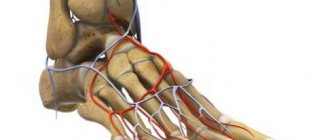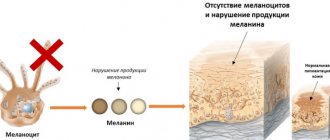Swelling of the limbs and face is a common problem for modern people. Lymphatic edema of the legs and face is characterized by difficulty in the outflow of lymphatic fluid, resulting in tissue compaction caused by the accumulation of lymph. This pathology is most common among women aged 35 to 40 years.
At the Yusupov Hospital, highly qualified specialists treat lymphedema using modern technologies. Diagnostics using European equipment makes it possible to identify the cause that provoked lymphedema of the leg or face, after which an individual therapy program is drawn up for the patient.
Lymphedema of the face
Lymphatic edema, which should be treated when the first signs appear, is a serious pathology. Lymphatic swelling of the face, if left untreated, can cause inflammatory and infectious processes, proliferation of connective tissue and the appearance of scars. Lymphostasis of the head and neck develops due to genetic disorders or a tumor in the affected area. As the disease progresses, tissue thickens and the face becomes enlarged.
When treating facial edema, specialists at the Yusupov Hospital use methods aimed at improving metabolism, stopping the development of pathology and preventing complications. Skin care and physical activity are important components of successful treatment to maintain muscle tone. At the Yusupov Hospital Rehabilitation Center, patients can take advantage of various procedures and activities aimed at treating facial swelling.
Lymphedema of the face
Head and neck lymphedema is a very common late treatment side effect for head and neck cancer. It is a chronic disease with potentially severe consequences for quality of life. Unfortunately, knowledge of the condition is poor and clinical studies are rare. Here we provide an overview of the current clinical understanding of the condition and how it can be managed.
Want to know more about how your experience compares to other patients? Check: “Is my head and neck lymphedema “normal”?”
Contents [hide] 1 Part 1. Clinical characteristics of head and neck lymphedema 1.1 what is lymphedema? 1.2 What is head and neck lymphedema and how does it occur? 1.3 What are the symptoms of head and neck lymphedema? 1.4 How is head and neck lymphedema diagnosed? 1.5 Risk factors for developing head and neck lymphedema after cancer treatment 1.6 Prevalence of head and neck lymphedema after cancer treatment 2 Part 2. Prevention and treatment of secondary head and neck lymphedema 2.1 Prevention and self-management of head and neck lymphedema after cancer treatment 2.2 Professional management of head and neck lymphedema after cancer treatment 2.2.1 gold standard treatment 2.2.2 Surgical options 2.2.3 Pharmaceuticals and supplements 3 comments or questions? 4 links Part 1: clinical characteristics of head and neck lymphedema what is lymphedema?
Lymphedema is a chronic condition of swelling caused by damage to the lymphatic system (“secondary lymphedema”) or malformation of the lymphatic system (“primary lymphedema”). Disruption of the normal function of the lymphatic system in an area of the body results in insufficient clearance of lymphatic fluid (lymph) from that area. When the blood transports oxygen and nutrients to the body's cells and collects waste for excretion, 80% of the fluid returns to the bloodstream while 20% enters the lymphatic system as lymph, a colorless liquid that is left over the volume. Eventually the lymph returns to the bloodstream in the heart.
More than just a fluid collection system, the lymphatic system is a vital component of the immune system, transporting immune cells around the body. Consequently, the blockage of lymph flow causes fluid buildup as well as other harmful changes, including localized immune depression. Lymphedema is typically seen in the extremities (arms and legs), but is also very common in individuals treated for head and neck cancer. Find out more about lymphedema here.
What is head and neck lymphedema and how is it caused?
Secondary lymphedema of the head and neck typically results from damage to the local lymphatic system by cancer biopsy or treatment (see Figure 1 for an illustration of some head and neck lymph nodes and vessels). Removal of lymph nodes during cancer biopsy or tumor resection is the leading cause of secondary lymphedema in patients with head and neck cancer. This is a direct consequence of the essential role of the lymph nodes in collecting lymph fluid from small lymphatic vessels and draining it into larger vessels leading to the heart.
Radiation therapy can also cause damage to any remaining lymph nodes and lymphatic vessels located in the radiation field, another potential cause of lymphedema. Unfortunately, a large number of nodules in the head and neck area make radiation-induced damage more difficult to avoid. Disturbance of the normal lymphatic flow in the head and neck leads to a buildup of lymphatic fluid, followed by chronic and progressive swelling that can affect various areas of the head, neck and face.
Lymphatic glands and vessels-of-the-head-and-neckFigure 1. Superficial lymphatic glands (nodes) and lymphatic vessels of the head and neck (Ref. 1). As with lymphedema of the arm or leg, head and neck, lymphedema must be caught and treated early to relieve symptoms and prevent or delay progression of the disease.
Uncontrolled swelling causes additional damage by overstraining the remaining normal lymphatic vessels, and can also initiate a cascade of harmful events, including localized inflammation, immune system impairment, and eventually worsening swelling (which is called “non-punctate lymphedema”). further exacerbating the problem.
Hardening is the result of compositional changes occurring in tissue, including fibrosis (scarring), proliferation of connective tissue, and accumulation of fat (and to a lesser extent muscle and bone) - a possible result of altered stem cell behavior. This advanced stage of the disease is less responsive to typical treatments and may require surgery (see below).
What are the symptoms of head and neck lymphedema?
The main symptom of head and neck lymphedema is swelling, usually developing 2-6 months after cancer treatment. In the early stages of head and neck lymphedema, swelling can be difficult to observe. Head and neck lymphedema can develop internally in the larynx and pharynx (which are the various structures that make up the mouth and throat), or externally in the neck and face, or a combination of both, depending on which lymphatic channels are obstructed.
Less commonly, the tumor may progress to the point where it creates serious functional problems such as difficulty breathing and swallowing, as well as obvious problems with body image and associated social output arising from neck and facial deformities (Art. 2). Overall, head and neck lymphedema has the potential to seriously impair patients' quality of life. To see how your symptoms compare to a group of 1,202 head and neck cancer patients at MD Anderson Cancer Center (MDACC) in Texas, check out our post: “Is my head and neck lymphedema 'normal'?”
Symptoms of mild to moderate head and neck lymphedema may include:
Visible swelling under the chin, in the neck, or in the face, including the eyes and lips. A feeling of tightness or limited movement in these areas, including the jaw or shoulders. Symptoms of moderate to severe head and neck lymphedema may include:
Significant swelling of the face and neck Swelling that feels hard and hard to the touch Visual or auditory impairment Difficulty breathing, swallowing, eating or speaking Congestion of the nose, chronic ear pain How is head and neck lymphedema diagnosed?
Lymphoscintigraphy or other imaging techniques that involve injections of contrast agents to visualize lymphatic fluid flow pathology may lead to a definitive diagnosis of lymphedema, but it is usually diagnosed using gentle means. The presence of lymphedema is usually assessed based on observations, physical examination findings, the patient's symptoms, and a review of the patient's history. Alternative causes of the tumor need to be determined. Accordingly, early stages of the disease can be particularly difficult to diagnose.
Subjective patient findings (such as a feeling of "tightness" or "heaviness") are often the earliest indicators, while objective measures of volume change may be more difficult to obtain. This is especially true for early internal lymphedema and early external lymphedema in areas such as the chin, where there is no symmetrical counterpart that can be used for comparison (unlike swelling on one side of the face that can be compared to the other unaffected side).
External lymphedema is often classified into one of four common scales. However, standardization is lacking, and these scales appear to be imperfectly suited to capture the stage of head and neck lymphedema (Model Number/Ref. 3).
A modification of the Foldy score for categorizing extrinsic lymphedema does a good job of capturing the range of soft tissue changes seen with the progression of untreated head and neck lymphedema (see Table 1), although further validation of the score is warranted (see Table 1). 4).
Feldi Lymphedema Scale Rating Modified for Head and Neck Table Lymphedema 1: Modified Feldi Scale for Head and Neck Lymphedema Clients Practically speaking, head and neck lymphedema secondary to cancer treatment can be defined as a tumor that develops three or more months after treatment (ref. 5). This is during the time that normal acute post-treatment swelling is usually visible.
External lymphedema is identified by visible swelling of the face or neck, and can best be quantified using a “composite facial score,” consisting of seven measurements, as well as a “composite neck score,” consisting of 3 measurements (Model Number/Ref. 4). Measurements are needed to establish baseline conditions, monitor changes, and improve tracking.
In contrast to internal edema, swelling of the mucous membrane and soft tissues of the pharynx and larynx is visible. Internal lymphedema is more difficult to quantify. Endoscopy or a speculum examination by an experienced practitioner can be used to measure 11 internal anatomical sites and two Patterson sites (item 5).
Risk factors for head and neck lymphedema after cancer treatment
Fundamentally, the risk of lymphedema increases as a function of lymphatic damage. Perhaps the best predictor of likelihood is the number of lymph nodes that were removed during surgery; The more nodes removed, the greater the likelihood of developing head and neck lymphedema. Studies of head and neck lymphedema show that the total dose of radiation therapy, as well as the number of days of radiation therapy, also increases the risk of developing lymphedema (Ref. 6).
In addition to the number of lymph nodes removed, additional factors may change your chances of developing head and neck lymphedema. A study of arm lymphedema secondary to breast cancer shows that the chance of lymphedema increases for patients who:
Have received chemotherapy before or after surgery (Ref. 7), Have a high Body Mass Index (BMI), Have genetic factors associated with lymphedema Report lower overall health scores (Ref. 7)
Lymphedema of the legs: causes
The pathological process in 90% of cases affects the lower extremities. Lymphedema of the legs, which should be treated under the guidance of an experienced specialist, occurs due to various reasons:
- surgical interventions to remove lymph nodes;
- overweight;
- heart failure;
- phlebeurysm;
- congenital underdevelopment of the lymphatic system;
- tumors of the lymphatic system;
- kidney disease;
- injuries.
Lymphedema of the leg, which is caused by the accumulation of fluid with large proteins, can increase rapidly. The pathological process causes not only physiological, but also psychological discomfort associated with changes in appearance and choice of clothing. After diagnostics, specialists at the Yusupov Hospital determine how to relieve lymphedema in the legs and offer patients effective treatment methods.
Lymphatic drainage massage: who needs it?
Lymphatic drainage is a massage that affects the deep layers of the dermis.
The combination of pressing, stroking and vibrating movements of varying intensity allows you to stimulate cellular metabolism, normalize blood flow, and accelerate lymph drainage. As a result, the skin renews itself faster, acquires a healthy color, elasticity and density, and swelling disappears. Properly performed lymphatic drainage massage can:
- tighten the oval of the face;
- soften nasolabial and nasolacrimal folds;
- eliminate bags under the eyes and open your eyes;
- get rid of a double chin;
- smooth out small wrinkles;
- improve skin perception of creams, serums and other cosmetics.
Lymphatic drainage massage tightens flabby skin and helps reduce swelling.
The effect will be noticeable after the first sessions. Massage can quickly tone and rejuvenate sluggish, flabby, stretched skin. Cosmetologists recommend carrying out lymphatic drainage massages in courses of 10-12 procedures, followed by a break. In the process, you can use basic plant and essential oils, combine massages with peelings, deeply nourishing masks or tightening serums.
Salons offer a variety of lymphatic drainage massage options. Follow the most popular Spanish, Zogan (Japanese), vacuum. Hardware techniques are also actively used, deeply working all layers of the dermis and subcutaneous fatty tissue. However, not everyone has the opportunity to constantly visit the salon. Girls who do not want to regularly go to a massage therapist can learn basic techniques by studying detailed diagrams and watching several video tutorials posted on thematic blogs.
Among the main benefits of massage at home:
- ease of implementation;
- versatility;
- takes a little time;
- the ability to combine with other care procedures;
- quick results.
Home treatments can save you a lot of money. Prices for lymphatic drainage massage in Moscow salons start from 3,000 rubles.
The maximum benefit will come from procedures using a combined technique. They combine techniques from different techniques; the duration of treatment of each area depends on the characteristics of the face. Cosmetologists recommend paying special attention to problem areas: the lower jaw and chin, cheeks, and upper neck.
Tapping and pinching movements will help improve tone.
Lymphedema of the legs: treatment
Lymphatic edema of the legs, the treatment of which causes a lot of controversy among specialists, requires complex therapy. To remove excess fluid from tissues, specialists use methods that improve blood supply to the extremities:
- therapeutic exercises;
- swimming;
- physiotherapy;
- taking medications;
- use of bandages and compression garments;
- manual lymphatic drainage;
- foot skin care.
When treating lymphedema of the legs in the later stages of development, surgical intervention is used. The achievements of modern medicine, when conservative methods of therapy are ineffective, make it possible to perform operations with minimal intervention
When treating patients diagnosed with lymphedema, conservative methods are a priority. During the complex diagnostics, ultrasound, MRI, blood and urine tests and Doppler ultrasound of the veins are performed.
Lymphatic anatomy of the face and neck
Facial lymphatics follow a path parallel to the facial and jugular veins. Therefore, in order to understand the lymphatic anatomy of the face, it would be correct to briefly study the arterial diagram of the face.
The artery of the neck is represented by the primitive carotid arteries (one on each side of the neck), at the level of the hyoid bone (under the lower jaw) in the form of two branches:
- the internal carotid artery is responsible for delivering blood to the brain;
- The external carotid artery branches into various structures in the neck and also continues on the face as the facial artery, supplying blood to the facial muscles.
The facial vein takes oxygenated blood and carries it to the jugular vein. There it joins the subclavian vein, forming the brachiocephalic venous trunk (in the chest). As a result, a superior vein is formed, which ultimately ends in the right atrium of the heart.
Permitted work for lymphatic edema of the lower leg
Sedentary and monotonous work causes venous congestion, which is one of the causes of the pathological process. Permitted work for lymphatic edema of the lower leg is associated with moderate physical activity.
With this disease, work should not be associated with static loads and heavy lifting. During the consultation after the examination, specialists at the Yusupov Hospital determine the extent of tissue damage and develop a treatment program. For each patient, specialists at the Yusupov Hospital individually determine the permissible loads and the optimal type of activity.
Relationship between the lymphatic and circulatory systems
There are many groups of lymph nodes on the face. The nodes are connected by ducts through which lymph, a clear liquid, flows. The parotid nodes receive lymph from the forehead and the outer half of the eyelids. The facial nodes form a “chain” (ducts with nodes) that runs parallel to the blood vessels. The ducts carry lymph from the eyelids, nose, lips and chin. The lymph is then directed to the jugular ganglia of the neck, which form chains around each of the jugular veins and pump the lymph into the large lymphatic or thoracic duct.
Lymphatic drainage and its benefits
This is a type of massage to remove excess fluid and toxins from the body, treat cellulite and swelling.
Lymphatic drainage does not thin a person, as it does not remove fat, but rather reduces volume to eliminate swelling in the body. The massage should be done in the direction of the lymph nodes, applying slight pressure to the skin, as excess pressure can obstruct lymph circulation and compromise its benefits.
You should know that only a qualified specialist can perform lymphatic drainage efficiently. A bad massage can cause poor toxin mobilization and clogged nodes, which can lead to health problems.
Benefits of Facial Lymphatic Drainage
- promotes fluid drainage;
- reduces dark circles and bags under the eyes;
- eliminates signs of fatigue;
- improving blood circulation and supplying the body with nutrients;
- cell restoration and improvement of skin condition;
- increasing oxygen supply;
- relieves inflammation and prevents the appearance of acne;
- relaxes facial muscles, ideal for relieving stress, calms the nervous system, improves sleep;
- treats scars and relieves swelling.
Lymphatic drainage is not recommended for people with high blood pressure, rheumatism, asthma, lupus, cancer, arthritis, thrombosis or thyroid problems.
Lymphedema after circumcision
Lymphatic edema, circumcision of the foreskin is one of the causes of which, is rare in comparison with other types. When tissue is removed, damage occurs, causing swelling and hematomas. Traumatization of tissues can occur as a result of improper medical manipulations or concomitant diseases, as well as during fusion of the head and foreskin. If lymphedema appears and the condition worsens after circumcision, you should consult a specialist to identify the causes of the disorders.
Lymphatic edema of the legs, which is treated at a high level at the Yusupov Hospital, can cause irreversible changes. Timely treatment of lymphedema of the legs and face is aimed at eliminating both the underlying disease and associated disorders.
At the rehabilitation clinic you will be provided with highly qualified assistance for lymphedema. Pre-registration for an appointment with specialists is carried out by calling the Yusupov Hospital.
Cosmetic procedures for the treatment of facial swelling
If it was not possible to establish tissue drainage in time, then cosmetic procedures with a lymphatic drainage effect are an effective additional measure to combat swelling, such as:
- lymphatic drainage massage - can be hardware or manual, improves blood circulation, activates the movement of lymph, and also helps get rid of wrinkles and gives the skin elasticity;
- biorevitalization, SMAS-lifting, RF-lifting - procedures aimed at restoring water balance, activating blood flow, stimulating collagen production and accelerating lymph movement;
- microcurrent therapy - stimulates the dermis, activates capillary blood circulation, eliminates pastiness and pronounced wrinkles.
To achieve maximum effect, cosmetic procedures must be carried out in a course. The number of sessions and their frequency are determined by the cosmetologist at a preliminary consultation.
Lymphatic drainage: Questions and Answers
A few cosmetology tricks are in the answers; they will allow your lymphatic system of the face and neck to look better.
What will I achieve by using a lymphatic drainage facial mask?
Answer: The first thing to think about when using a particular product is: “Is the product compatible with my skin and needs.” The face mask used should contain a high concentration of natural ingredients, which will provide the skin with intense nutrition.
Should I use any additional product? Is peeling mandatory?
Answer: It is very important to cleanse your face and gently exfoliate it so that the ingredients in the mixture are better absorbed. Cosmetics within the professional masks used have options that help to further enhance the effect.
In what order should the procedure be carried out?
Answer: The first thing you should do is cleanse your face using a cleansing brush or washcloth to gently exfoliate. Then apply a serum tailored to your needs, moisturizer, eye contour and finally a mask. This is only if the applied product does not need to be washed off. Otherwise, you need to start by gently cleansing/exfoliating your skin. Then, after 20 minutes, you should wash your face, dry your face with a towel, apply toner, serum and moisturizer.











